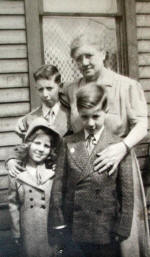 |
| HOME | GLOBAL | DISTRICTS | CLUBS | MISSING HISTORIES | PAUL HARRIS | PEACE |
| PRESIDENTS | CONVENTIONS | POST YOUR HISTORY | WOMEN | FOUNDATION | COMMENTS | PHILOSOPHY |
| SEARCH | SUBSCRIPTIONS | JOIN RGHF | EXPLORE RGHF | RGHF QUIZ | RGHF MISSION | |
|
|
|
Joseph L. Kagle, Jr. Peace Essays
|
|
Pittsburgh, My Home
Pittsburgh, Pennsylvania, Perry High School, 1950.
These are not the dreams of the young; or the idle romantic ideals of pre-mature senility. It is the gnawing in your stomach. It is the restlessness. It is that pushing from within that you have no control over. It is a living hell to be driven. But it is more important than drifting. It is more meaningful than the academics of apathy.
This thing, this gnawing awareness is a feeling that must be followed, no matter how far a field, or hard the travel, or difficult the misunderstanding. A man must find out the ‘Why?’ of his living, his existing, his working and his… his everything else.
“At that time of life, peace is an abstract that has not been envisioned or explored. All of life is just one step in front of the last step. Peace (and war) are left to older people.” The events that happen in another city can bring home where you were born and the lessons that were learned long ago. You take these lessons into your inner being and they help to shape decisions for peace or violence. The inner city teaches lesson different than country upbringing.
Inner City Lessons From Pittsburgh
As I sadly watched the burning images on television of the violence in Los Angeles, I went over in my mind what lessons I carried with me as I journeyed from the inner city of Pittsburgh to the place where I now live in Waco. There are city lessons that stay for life, lessons that begin as vivid images. On the street, all the kids played. In the inner city, that was the playground. I opened the fire hydrant and went home crying because a fat lady gave me hell. I was six. I remember her red face to this day. There was an old teacher, with a faded wig, who towered over the class of little people in the third grade. She was hard as nails. We knew that even when she smiled a lot. She took my drawing of Goldilocks and hung it in front of the class, giving praise for the details and the labyrinth of rococo sunlight that resembled curls, saying "When you are in the fifth grade, I will send your name to the museum for training." To her word, when I reached the fifth grade, they called me to go to the large museum that Andrew Carnegie built in Oakland and I studied with others who made-images-in-their-minds appear on paper.
In Pittsburgh, every school child had the opportunity to be part of a rich cultural tradition. We saw it happening; we knew it was possible. Many creative individuals, from many ethnic and racial beginnings, worked side by side. We learned from each other.
In my neighborhood, bordering the black neighborhood, beside the Italian neighborhood, intersecting the Croatian neighborhood, across town from the Jewish and Greek neighborhoods, there was a cultural tradition of interaction on the edges of neighborhoods while staying within your own boundaries, your own invisible lines.
Art class was a bore in high school until a new teacher came. He gave me few but firm rules. "Draw and paint what you know." That start carried me taught me that traditional values are worthwhile as long as everyone can obtain them in our democracy. My days in the parks of Pittsburgh taught me that nature can shape personal aesthetics. My days in Pittsburgh taught me that we all live in a global village. Once you contact the chiefs and the medicine men for approval of an action, anything is then culturally possible. My days in Pittsburgh's Carnegie Museum taught me that a museum is an idea in motion and works of art are the motor-force for that idea: to be sensitive to cultural differences while pointing out our human similarities. My days in Pittsburgh taught me to use the gift of laughter to cope with the craziness. There are important lessons in the inner city to be learned and some to be unlearned if we are to live together in our stew pot global inner city.
|
| RGHF peace historian Joseph L. Kagle, Jr., 2006 |
